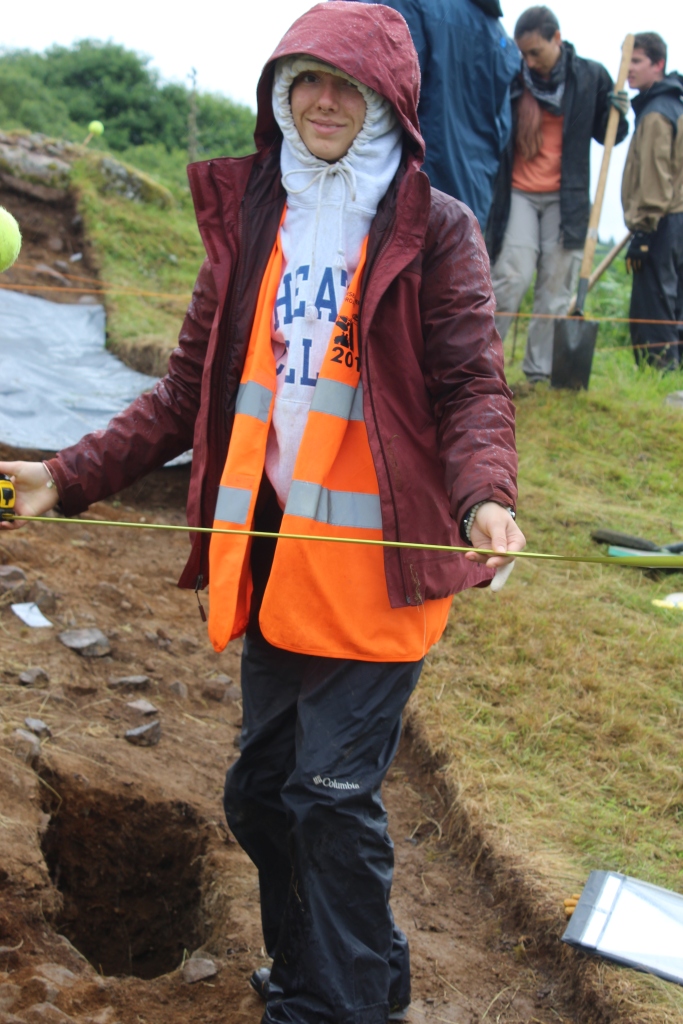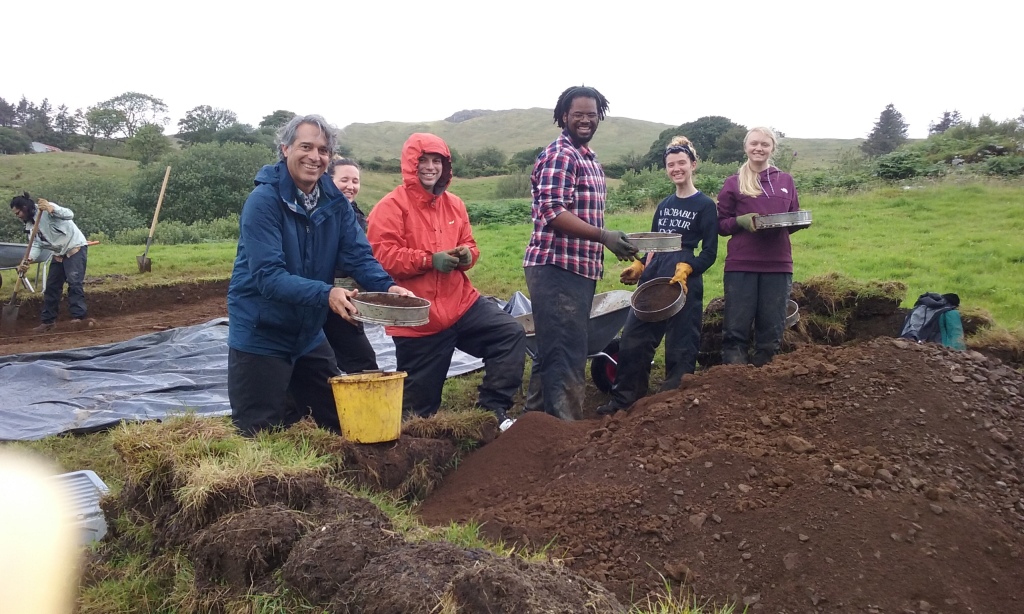2022
Four trenches were active in the 2022 field season.
Trench 1
From Trench 1 it has become clear that the central enclosure of the site, defined by the graveyard and the now-unbounded area to the immediate south of the graveyard, sits on a drumlin, with a core of natural soil and stones of varying size. As determined last year (Beglane 2021), the south-west extent of this central enclosure, exposed in Area A, appears to have been revetted using densely packed field stones to bound the central enclosure. This would have prevented slippage of the enclosure and would also have formed a distinctive and attractive feature if left exposed after construction. This has been termed the Upper Revetment.
Below the Upper Revetment, in Area B and extending into Area H, was a flat region extending in a north-west direction. Excavation of this has yielded an infilled enclosure ditch, following the line of the potential ditch identified using geophysics. This ditch had a depth of c. 0.6m below the surrounding ground. At the mid-fill level the ditch appears to have used for in-situ craftworking. In previous years a number of fragments of some form of slag and a piece of half-melted glass were recovered, as well as limited areas of in-situ burning at upper fill levels. Extensive charcoal deposits identified in 2021 have now been revealed to be the result of three bowl-shaped depressions at the mid-fill level. Two of these were filled with alternating deposits of burnt soil and charcoal, while the third had a large flat slab at the base, with some evidence for burning, and had then been deliberately backfilled with heat-affected stone. Comparison with sites reviewed by Dolan (2012) and discussions with metalwork specialist Angela Wallace (pers. comm.) suggests that this may be evidence for metalsmithing taking place within the ditch. Since substantial quantities of charcoal were recovered from these features, it should be possible to date them, and it is likely that environmental information regarding the surrounding landscape will be obtained. A number of stone finds and some charcoal were recovered from the lowest fills of the enclosure ditch itself, and dating of these charcoal deposits will hopefully yield evidence for its origin, which is presumed to relate to the early medieval period.
Trench 3
In Trench 3, the 2021 excavation of cairn DG084-001010 showed that it had originated as two cairns. For 2022 no further work was conducted on the western cairn. At the end of 2021 the eastern Cairn appeared to be formed around a sub-rectangular central chamber, defined by stones C3090, including an upright slab, and filled with loose stone. In 2022 it became clear that what was thought to be stones forming the east side of this chamber were in fact supporting the upright slab in the centre of a larger, oval chamber, and that the limits of the chamber were further to the east. As with the western cairn, the height of these on the uphill, north side was less than on the downhill, south side, so that both of these appear to have originated as flat-topped platform features. Furthermore the upright slab was similar to that found in Trench 5, and both are likely to have formed the focal points of these platform cairns at the time of their creation.
To the east and north of the holy well, the slumped stone from the west side of cairn DG084-001009 has now been set back at less than the angle of repose and the material from this area rebuilt at the east side of the cairn, resulting in a much more stable structure. At the north-west extent of the cairn, immediately north of the well, an area of flat slabs was exposed which may at one time have formed a ‘shelf’ for placing and displaying offerings at the well. This has been re-covered to provide a stable slope at the northern extremity of the well. Overall, the work in this area has succeeded in fully exposing the well surround, and a temporary wooden cover has been put in place until a more permanent solution can be obtained.
No firm dating is yet possible for the cairn features. There are some charcoal samples that may be suitable for radiocarbon dating, including from low levels within the cairns. The majority of artefacts from this area are of nineteenth- to twenty-first-century origin. A few artefacts such as hammer stones and hone stones are difficult to date on stylistic grounds.
Trench 4
A scarped and flattened area was exposed in Trench 4. This forms the return for an inner enclosure pre-dating the current graveyard boundaries. This feature was visible topographically and in the geophysics, and may represent a base for a previous enclosure wall, fence, or other boundary of this inner enclosure. It surrounds the area of the cairns within the graveyard, including cairn DG084-001007, which was investigated in Trench 5.
Trench 5
The aim of Trench 5 was to investigate the nature of the possible upright slab in the centre of cairn DG084-001007. This cairn was located at the highest point within the site and provides a focal point for the site. The presence of an upright slab was confirmed; disappointingly however this was undecorated and weathered. As with the two cairns that make up DG084-001010 that were investigated in Trench 3, this cairn seems to have originated as a low, flat-topped platform surrounding and supporting the upright slab. To the south was a setting of white quartz stones, while to the north the platform was topped by flat slabs. The platform itself and the upright slab were left unexcavated and in situ. While a number of finds were recovered from Trench 5, none were closely datable and no charcoal was recovered.
The excavated lands at Disert are owned by Mrs Noreen Boyle and farmed by Con Boyle and are accessed across private lands owned by Ann Boyle and Breege Cleary. The cooperation and interest of these individuals is sincerely acknowledged as this project would not have been possible without them.
In 2022 the project was funded by Atlantic Technological University, California State University LA, the Institute for Field Research, and Creative Ireland, Donegal County Council and the Department of Tourism, Culture, Arts, Gaeltacht, Sport and Media.
Disert Community Excavation
21 June to 23 July 2021
As part of our contribution to The National Heritage Week for 2021, the Disert Heritage Group are putting forward a video of some of the findings of the recent excavation, presented by Dr Fiona Beglane. Due to COVID 19 restrictions this year’s excavation was a completely community-based project. During five weeks in June and July, a total of 33 people took part in opening two trenches and recording the findings A total of 33 people took part over the course of the excavation – we are very grateful to them all. Among the volunteers we had a mix of experienced archaeologists, former and current students of archaeology and folks who wanted to have a go. According to the feedback most people enjoyed the experience and learned or practiced new skills. Much of the day-to-day operations were recorded in short videos, participants introduced themselves and spoke a little about what they were doing, these videos can be viewed on the Disert Heritage page on Facebook.

The excavated lands at Disert are owned by Mrs Noreen Boyle and farmed by Con Boyle and are accessed across private lands owned by Ann Boyle and Breege Cleary. The cooperation and interest of these individuals is sincerely acknowledged as this project would not have been possible without them.
For 2021 this project was funded by IT Sligo and Donegal Co. Co. The project has been supported though the Colmcille1500 Grant Scheme which is funded by the North West Development Fund and Creative Ireland, in conjunction with and supported by The Executive Office and The Irish Government. In previous years we have also received funding from the Heritage Council, Institute for Field Research, Connecticut College, and California State University, LA.
Previous Excavations
The Disert Heritage Project conducted the first season of an archaeological excavation between 1 July and 19 July 2019. This was carried out in conjunction with IT Sligo, California State University, LA, the Institute for Field Research, Connecticut College and Donegal Co Co. As well as the excavation itself there were a series of social and cultural events – see our Facebook page for details. The community events were supported by Donegal Co. Co. Heritage Office and Donegal Co. Co. Development Fund. We also hosted guided tours of the excavation and had places for community volunteers to take part in actually digging.
You can download a copy of the Preliminary Excavation Reports for 2019, 2021 and 2022, which were submitted to the National Monuments Service.
We are currently working on the post-excavation analysis. If you can help to fund this then we would really appreciate any donations you can make, however small.
Some excavation photos:











A montage of visitors – thank you to those who visited, and especially to those who brought home baking!
















